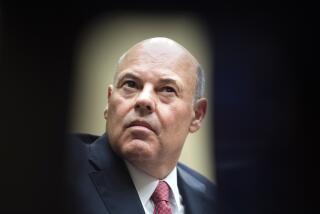Broad Rally Gives Wall St. New Hope
Doug Foreman and Scott Black are unlikely ever to see eye to eye on the stock market.
Foreman, a money manager and principal at L.A.-based Trust Co. of the West, owns many of the Internet stocks that have soared anew this year and is a big believer in the technology sector in general.
Black, president of Delphi Management in Boston, considers most tech-stock buyers at current prices to be delusional. He focuses exclusively on “value” stocks -- issues such as American Axle & Manufacturing, a car and truck axle maker whose shares trade for about seven times estimated 2003 earnings.
But if they can’t agree on the merits of individual stocks, Foreman and Black have one thing in common: Neither is having trouble finding plenty to buy in their favorite market niches.
And that goes a long way toward explaining why the rally on Wall Street has been so broad and so powerful over the last two months. On Friday, the Dow Jones industrial average closed at 8,850.26, its highest level since December. The Standard & Poor’s 500 reached its best level since July, and the Nasdaq composite hit a one-year high.
Since March 11 the S&P; index has risen 20.3% -- a percentage gain that historically has often signaled the start of a new bull market.
It has been comforting for some investors who have stayed on the sidelines to say this rally has been the work of hedge funds and other short-term traders, and that it soon will flame out. Haven’t they all since the bear market began in March 2000?
But crediting (or blaming) the hedge funds ignores the participation of investors such as Foreman and Black: money managers who typically seek to hold stocks for a period longer than the average life of a fruit fly, and whose instincts tell them that this is a good time to be putting money into equities.
Neither man can guarantee his clients that the market’s five-year lows reached in October marked the death of the bear. Neither can say there is no risk of another panic-inducing terrorist attack on the scale of Sept. 11.
They can only follow their investing disciplines and, like everyone else, hope for the best.
The difference between them and the average small investor is that they get paid to analyze and to take action, while many individuals have felt better putting off any discussions that might lead to committing new money to the stock market.
It isn’t surprising that people would be leery about Wall Street after the terrible losses of the last three years and the wave of financial scandals. But doubts always are high at the start of bull markets. That’s what makes for opportunities.
Foreman sees the market as “littered” with stocks whose prices, by his estimation, don’t reflect the companies’ earnings potential once the economy picks up speed. He includes on that list such names as e-commerce software supplier BEA Systems and temporary-help provider Robert Half International.
Black is more understated, but it’s the same basic idea when he says, “There are good businesses out there that are reasonably priced.”
One example, he says, is RenaissanceRe Holdings, a catastrophe-insurance company which, like American Axle, is priced at about seven times this year’s estimated earnings per share -- compared with a price-to-earnings ratio of about 18 for the S&P; 500 index.
Foreman’s stocks, overall, are having a better year than Black’s so far. Foreman’s TCW Galileo Aggressive Growth fund is up 29% since Jan. 1; Black’s Kobren Delphi Value Fund is up 10.7%. But from 2000 through last year, as the bear market raged, Black’s value-oriented approach trounced Foreman’s focus on growth stocks.
The fact that both the value and growth stock sectors are having a good year is another sign of the breadth of the market’s advance. And a broad rally is a better way to start a serious uptrend than a rally led by a relative few market sectors.
Some financial pros also have been encouraged by the warnings that have accompanied even some of the most bullish market commentaries this year. A popular refrain is that stocks, at best, will be stuck in a trading range for years, and that share prices probably are approaching the top of that range -- so it might be smarter to stay away.
“The beauty of this rally is that nobody believes it,” said Ted Bridges, a principal at Bridges Investment Counsel in Omaha. “Expectations are low.”
So much the better if that means money on the sidelines just keeps trickling in, keeping the advance on the steady pace it has seen since mid-March, said Marc Pado, U.S. market strategist for New York-based brokerage Cantor Fitzgerald.
To him, the market “isn’t a value question today -- it’s a supply and demand question.”
A total of more than $5 trillion sits in money market mutual funds and short-term bank savings accounts, Pado said.
“That is pretty incredible,” he said. “Every day is a day when they aren’t making money,” given short-term interest rates that now are under 1% annualized.
Most of that cash probably will stay exactly where it is. But if even 7% were to shift to stocks over time, that would be a $350-billion infusion for the market.
Pado is a Wall Street “technician” -- someone who studies the action of the market itself, such as share price trends and trading volume, to look for clues about the next big move.
Many chart-watchers, he said, are focused on the 9,000 mark for the Dow, which would be a 1.7% rise from Friday’s closing level. The Dow has neared that level three times since July, only to fall back each time.
Pado has been arguing for months that a new bull market has begun. Many of his peers have disagreed. Now, he says, “The bears are saying that if we go through 9,000, then it’s a new bull market.”
That’s the kind of definitive statement the average investor might be craving, because it sounds like the all-clear signal, a guarantee of hefty profits if you get back into stocks, any stocks.
Of course, it would guarantee nothing if more people on Wall Street declare that this is, indeed, a new bull market. How high prices might go, which stocks would be favored or shunned, how much volatility there would be along the way -- all of these questions still would challenge investors.
Does it matter what we call it? For many market veterans, the appeal of stocks now is rooted in one assumption and one fact.
The assumption is that the economy is going to get better, albeit perhaps more slowly than most people would prefer. The fact is that interest rates are at generational lows, which means that a principal alternative to owning stocks -- owning bonds, bank CDs or other fixed-income securities -- offers little in the way of competition.
“Stocks still look inexpensive relative to bonds, and that’s the choice most people have” in terms of their financial assets, said Bill Nygren, a partner at money manager Harris Associates in Chicago, which manages the Oakmark mutual funds.
Given the still-weak economy and deflation worries, Nygren said he doesn’t believe it’s outlandish for the yield on the 10-year Treasury note to be at 3.37%. But he also doesn’t believe it’s outlandish to assume that the stock market can do better than that annualized return over the next decade.
Tom Petruno can be reached at tom.petruno@latimes.com.
More to Read
Inside the business of entertainment
The Wide Shot brings you news, analysis and insights on everything from streaming wars to production — and what it all means for the future.
You may occasionally receive promotional content from the Los Angeles Times.










